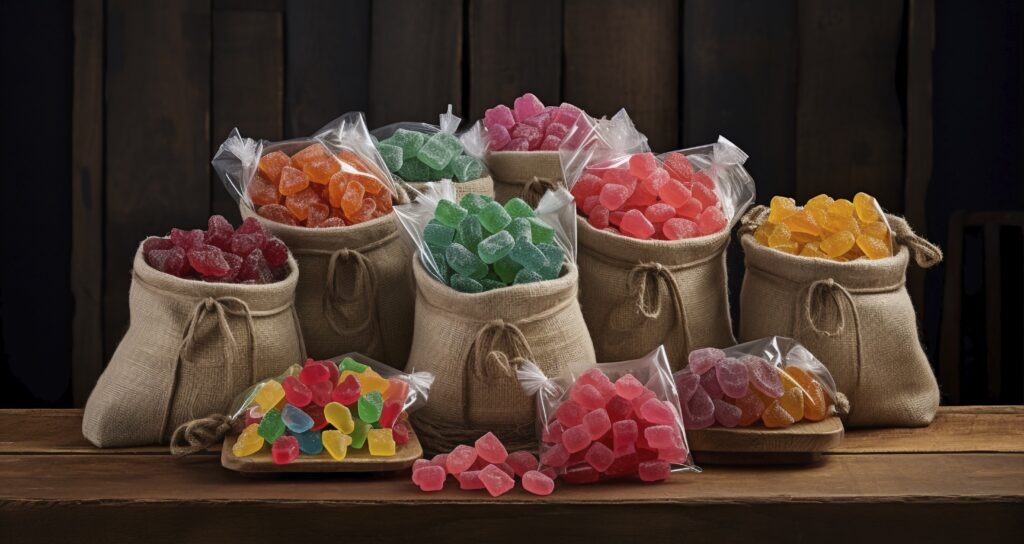Candies business: Starting your own business is an exciting struggle that requires careful planning and smart action. Whether you’re passionate about great products, have a unique idea, or see a growing market, there are several steps to successfully starting a business.
First, conduct extensive market research. It’s important to understand your industry, target customer group, and competitors. This research will determine your business plan, which should include your business goals, strategies, target markets, financial forecasts, and marketing plans. A good plan serves as a road map and can also be useful for obtaining financing from investors or lenders.

STEP 1. CANDIES
Starting a successful candy business begins with selecting the right candies to sell and sourcing them wholesale is key for competitive pricing and product variety. Here’s how you can approach it:
-
- Sourcing Options:
-
- Local Suppliers: Explore nearby candy shops or distributors for convenient access and reliable service.
-
- Online Platforms: Websites like Indiamart offer a broad range of candies at wholesale rates, typically priced between ₹50 to ₹70 per pack.

-
- Considerations for Supplier Selection:
-
- Quality: Ensure that the candies meet high-quality standards to satisfy your customers.
-
- Variety: Look for suppliers that offer a diverse selection of candies to cater to different tastes and preferences.
-
- Price: Seek competitive wholesale prices to maximize your profit margins.
-
- Reliability: Choose suppliers known for their reliability in terms of supply consistency and delivery efficiency.
-
- Carefully evaluating these factors will help you establish a robust foundation for your candy business, ensuring customer satisfaction and business sustainability.
STEP 2. SMALL TOYS
-
- Adding small toys to candy pouches is a strategic way to captivate and delight children. This method enhances excitement and engagement by tapping into children’s natural curiosity and excitement for new toys. The presence of a toy turns a simple candy pouch into a more desirable item, increasing its appeal.

-
- The surprise element of discovering a hidden toy makes the candy experience more thrilling and memorable, creating positive moments that can lead to repeat purchases and brand loyalty. Additionally, small toys are practical and cost-effective, easily sourced from retail stores or online marketplaces at a low cost, typically between 0.25 to 0.30 paise per item.
-
- This affordability ensures that adding toys to your candy pouches is economical. Moreover, this unique selling proposition differentiates your product from competitors, making it a strong marketing point that attracts both children and parents seeking added value in their purchases.
Overall, incorporating small toys into candy pouches is a simple yet effective strategy to enhance product appeal, create joyful experiences for children, and potentially increase sales and customer loyalty.
STEP 3. OFFER
In the competitive candy market, making your products stand out and appeal to your target audience, especially children, is crucial. One effective strategy is to include toys inside your candy packaging. Children are naturally drawn to toys and often find them more exciting than the candy itself. By adding a small toy or trinket with your candies, you can leverage this fascination to your advantage.
This tactic not only enhances the appeal of your candies but also generates anticipation and excitement. Kids will eagerly purchase your toy-filled candies, eager to discover the surprise toy inside. This can lead to increased sales and foster customer loyalty, as children and their parents may prefer your brand for the chance to collect different toys.

Furthermore, integrating toys distinguishes your candies from others in the market, injecting an element of fun and engagement that grabs the attention of both children and their parents. By delivering a unique and enjoyable experience, you position your candies as a more enticing and memorable choice.
In summary, offering candies with toys inside is a strategic way to cater to the preferences of your young target audience, driving higher sales and establishing stronger brand recognition in the competitive candy industry.
STEP 4. SELLING TIPS
To successfully market your product, it is extremely important to build strong relationships with local shopkeepers. Introduce your product to them personally and emphasize its special selling points. Offering shopkeepers a competitive dividend convinces them that there is a possibility of good returns, thereby motivating them to stock your product and encourage their customers.
It is usually a wise move to allow shopkeepers to keep stock on loan for a reasonable period. In this way, their financial pressure can be reduced, and they get the possibility to demonstrate your product to their customers without having to pay upfront. This helps build trust and makes it easier for them to include your product in their choices.

Increase visibility by placing eye-catching stickers or advertisements of your product in prominent areas of the store. These draw the attention of customers passing by the scene, increasing the chances of experiencing the product up close and trying it.
By implementing these strategies, you can effectively increase the sales of your product in the market and ensure its recognition and success among consumers and shoppers.
STEP 5. EXPENDITURE
Starting a candy business can be financially feasible, especially compared to other ventures. Initial investment is a key concern for many entrepreneurs, but with careful planning, startup costs can be manageable.
As mentioned, investing around ₹5,000 to ₹10,000 covers essentials like purchasing candies, packaging materials, small toys, and pouches. Candies typically constitute the largest portion of this budget, so sourcing quality confections is crucial.

Allocate funds for packaging materials such as pouches or boxes to present your products professionally. Including small toys or trinkets can enhance customer experience and set your offerings apart.
Startup costs may vary based on candy types, initial inventory size, packaging choices, and any needed equipment or supplies. Consider additional expenses like licensing, insurance, or workspace adjustments.
By planning and budgeting carefully, you can establish a solid financial base for launching and sustaining a successful candy business. With its low entry barriers and potential for profitable returns, the candy industry presents a promising opportunity for entrepreneurs passionate about sweet treats.


Great job 👍